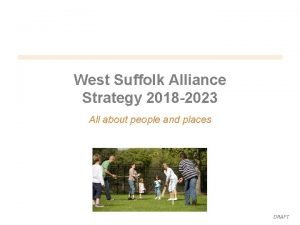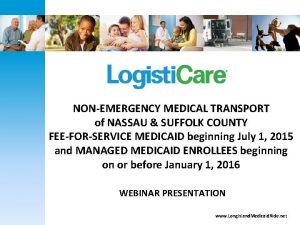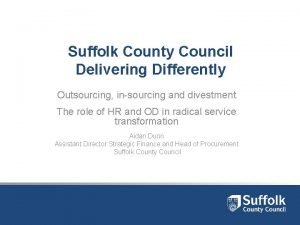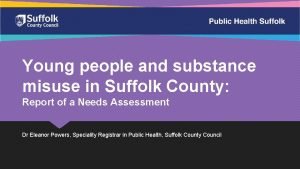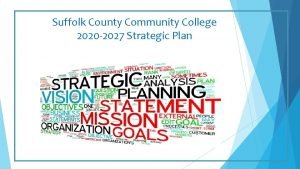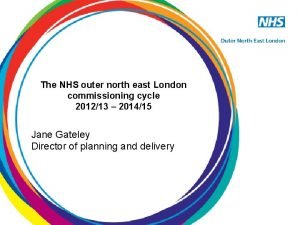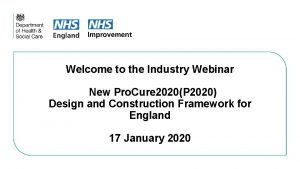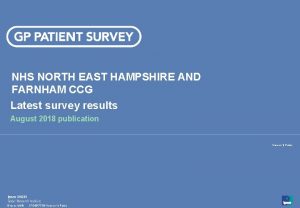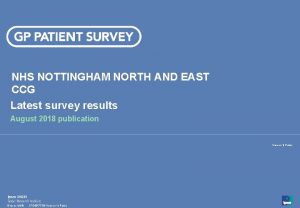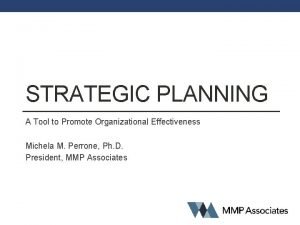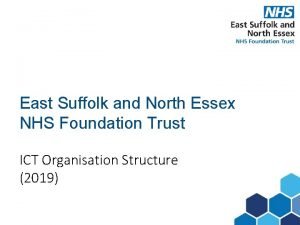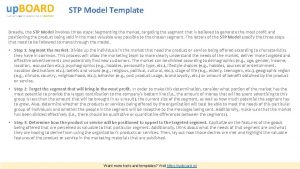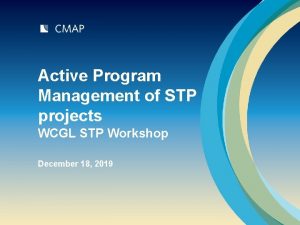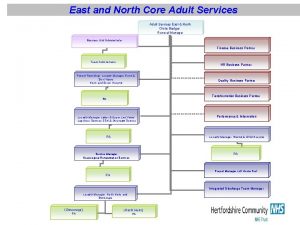Suffolk North East Essex STP Implementation Plan 20














































- Slides: 46

Suffolk & North East Essex STP Implementation Plan 20 th October 2016 Draft 1

Executive Summary In Suffolk and North East Essex, the NHS, general practice and local government have come together to develop a five year Sustainability and Transformation Plan. This is a unified plan to improve the health and care of our local people and bring the system back into a financially sustainable position. The system is passionate about creating a plan which will deliver our vision for people across Suffolk and North East Essex to live healthier, happier lives by having greater choice, control and responsibility for their health and wellbeing We have in place a strong, visible, collective leadership and a well-structured programme of work to address: • The increase in the demand for services • The workforce challenges • Reduction of inequalities in health outcomes • The key clinical priorities • Reducing unwarranted variation Our plan is also keen to explore opportunities: • With NHS Property Services to transfer assets into the system to maximise established resources • Extended joint commissioning arrangements with our local authorities • To co-commission primary care to enable the transformation of general practice • To change the way we engage with the regulators to align with our local system ambitions 2

Background and Purpose All health and care organisations within the Suffolk and North East Essex health and care system have been working together since March 2016 to develop a shared vision, priorities for action and to explore benefits of partnership working. It is clear that there are benefits for our population if we align our goals and actions, and share knowledge and skills. This Sustainability & Transformation Plan (STP) summarizes the work to date and outlines how our system-wide plan can be delivered across organisations, how the known and emerging risks can be managed, and how by working together we believe we can improve the quality and safety of care provided. This plan shows: • How we will work together to improve the health and wellbeing of our population • How we will combine efforts to improve safety and quality of care within Suffolk and North East Essex • How we will value and motivate the staff delivering care across our footprint and make Suffolk and North East Essex an attractive and enjoyable place to work • How we will share and align our infrastructure, assets, land technology to get the best out of them as we use them to deliver high quality care • How we will move towards a single systemwide financial control total to make best use of our shared financial resources This plan is informed by more than 40 separate pieces of public and voluntary sector engagement over the last 2 years to develop strategies for housing, mental health, including learning disabilities, primary care, end of life, maternity, cancer and hospital plans. “Three home assessments had been conducted at my mother’s house – could this not be one assessment and professionals share findings? ” Member of the public. NEE Big Care Debate 2 2016. “Using new technologies would help people to access services. Skype should be an option for all appointments where a physical examination is not essential. ” Member of the public. NEE Big Care Debate 2 2016. “My house is my home – not a placement. Information in my home should be for me, not staff. ” - Service user Suffolk Joint Learning Disability Strategy “To prevent crises from happening we need easy access to appropriate support from skilled multi-agency teams. ” Mental Health Conversations 2015 “We should be learning from the best…and from our mistakes. ” - Staff member WSH Our Patients, Our Hospital, Our Future 2015 3

Suffolk and NEE STP Overview Our vision is that people across Suffolk and North East Essex live healthier, happier lives by having greater control and responsibility for their health and wellbeing We will deliver this vision through three change programmes Over the next five years we will change the shape of health and care services within Suffolk & North East Essex. We will provide more resources in communities by reducing cost and demand in hospitals and improving quality. People will get more support and tools to help look after themselves. This will not be easy to deliver, however if we do nothing the predictions are that health and care services will not be able to survive in their current form and the workforce will not be able to meet demand. We will continue to work in partnership with patients, members of the public, partner organisations and our regulators and design safe and high quality services that are sustainable for the long term. 4

Our Population Demography We have a population of 953, 000 people. • By 2034 we expect a 50% increase in the number of people over 65. • Up to 2021 we expect a 3. 2% increase in the population, and 17. 9% increase in those aged 75+. • 1 in 5 children aged 4 -5 years in Suffolk and North East Essex are overweight or obese. For children aged 10 -11 years this rises to 1 in 3, and 2 in 3 for adults. • Close to half of all people in the footprint eat the recommended 5 or more portions of fruit and veg per day. • Close to 1 in 4 adults do less than 30 minutes of physical activity per week • Almost 1 in 5 people smoke; in our poorest communities this increases to 1 in 3. • In Suffolk 1 in 10 rural households have no access to personal transport. • Suffolk has higher levels of fuel poverty compared to its geographical neighbours Deprivation & Life Expectancy Healthy life expectancy (the number of years lived in good health) remains lower than overall life expectancy and is falling in some population groups. The difference in life expectancy at birth for males living in the highest and lowest deprivation levels between 2012 to 2015 is over 8 years. 11. 5% of our population in the 20% most deprived areas of England. (IMD 2016). This amounts to: 1 in 3 residents of Tendring and Ipswich, 1 in 10 residents of Colchester, and 1 in 9 residents of Suffolk. Hidden rural deprivation is a particular issue in Suffolk. 5

Health Outcomes People within Suffolk and North East Essex are living with a significant number of years in ill health or with a disability. Health outcomes are inequitable across the footprint. Mortality rates from causes considered preventable are variable across our geography. A quarter of people in Great Britain have one long term condition. By 2018, 45, 000 people in our area will have three long term conditions. Older people will have more long term health problems increasing the complexity of their care. People are living a significant number of years in ill health or with disability, potentially increasing demand on health and care services 6

Our Health and Care System Ipswich and East Suffolk CCG West Suffolk CCG Population: 385 k 40 GP practices Health income: £ 603 m Population: 243 k 24 GP practices Health income : £ 394 m West Suffolk Hospital Addenbrooke’s Hospital 41 mins 28 miles(2) 43 mins 34 miles(2) 48 mins 41 miles(2) 32 mins 21 miles (2) North East Essex CCG Population: 325 k 40 GP practices Health income: £ 569 m Colchester Hospital 38 mins 26 miles (2) 2 County Councils 7 District and Borough Councils 3 Clinical Commissioning Groups (CCGs) 104 GP practices 2 GP Federations 3 Acute trusts 2 main Mental Health providers 2 main Community Health providers 8 Community Hospitals 1 Ambulance Trust 2 Local Healthwatch 2 LMCs 177 Dental practices 184 Pharmacies 193 Optometrists Significant contribution from the voluntary sector & hospices System health and care income 2016/17: £ 2. 3 bn Mid Essex Hospital (1) Income based on 2015/16 place based allocations (2) Distances and timings per google maps Ipswich Hospital Population: 953 k Health and care expenditure 2016/17: £ 2. 4 bn System health deficit 2016/17: £ 84. 8 m 7

Our Clinical Vision Self Care & Independence Community Based Care Working with patients and the public, we will promote ways for people to help themselves, retain their independence and improve quality of life. Over the next five years more care will be provided in community settings to improve patient experience through care closer to home. This will also take pressure off our hospitals. People want to stay in their own homes for as long as possible. We aim to reduce emergency admissions and care home and nursing home placements. GP practices across our footprint will work together to improve patient access, share resources and support each other. Our “Good Lives, ” and “Supporting Lives, Connecting Communities” programmes work with health, social care and community partners aims to improve community safety and resilience for our population. Part of this will require people to take responsibility for their own wellbeing by making healthy lifestyle choices. Hospital Care Over the next five years our hospitals will provide less simple care which will allow them to focus on more complex and specialist care whilst working with other partners in the community. We will develop local alliances with the public and partners to provide integrated physical and mental health and social care rooted in local communities. We will offer patients more treatment and therapy outside of hospital, e. g. minor surgery, joint injections and clinic appointments. West Suffolk and Ipswich Hospitals are working closely with GPs and community partners to develop new models of urgent care and community services for patients. Shift of care from hospital settings to the community We expect the two Essex mental health trusts will merge within the next five years. During this time we will work with all our mental health providers to align physical and mental health care provision. Care will be more co-ordinated and it will be easier for the public to navigate around the system Ipswich & Colchester Hospitals have entered a long term partnership which may include specialisation of sites in different clinical areas to improve safety and quality of care.

Our Clinical Priorities As well as the key programmes outlined within our Sustainability and Transformation Plan we must deliver against the six specific clinical priorities within the NHS England Improvement and Assessment Framework. The table below sets out how our three CCG areas within the STP footprint are rated against each of the six clinical priority areas and the work underway against each one. In addition to these six clinical priorities, there is a focus on children and young people as part of wider local public sector strategies to improve outcomes – in Suffolk this is called the Families 2020 Strategy, and Children and Young People’s Strategic Plan 2016 onwards in North East Essex. Priority Ipswich and East Suffolk West Suffolk North East Essex Progress Cancer Needs Improvement Performing Well Needs Improvement Commitment to implementing Achieving World Class Cancer Outcomes (2016) working with the new East of England Cancer Alliance. A particular focus upon reducing variation and fragmentation of cancer service practice and improving cancer patient outcomes, by integrating the activities of all partner organisations across primary, secondary, community and social care. Dementia Needs Improvement Greatest Need for Improvement Greatest need for improvement Commitment to continuing to improve the diagnosis rate and care plan provision for people with Dementia as part of a wider transformation of dementia services. Diabetes Top Performing Well Needs improvement Continue to maintain strong performance and roll out the diabetes prevention programme across the footprint. Learning Difficulties Needs Improvement Performing well Continue to implement the LD Transforming Care Plans and LD Strategies with a focus upon reducing the reliance on inpatient provision. Maternity Performing Well Needs improvement Continue to maintain strong performance and implement the Better Births Five Year Forward View recommendations. Mental Health Needs Improvement Needs improvement Key focus on improving mental health service provision and integrating physical and mental health through the mentally healthy communities 9 programme within this STP.

Our Safety and Quality Challenges Our aim is to commission and provide high quality care for people within Suffolk and North East Essex. Whilst many services are of very high quality we know that not every service is as good as we would like. There are some specific areas we need to improve: Unwarranted Variation across the System • Patient outcome opportunities in a range of specialties as identified in Right. Care • Referral, prescribing and clinical pathway variation in outcomes from General Practice • Significant variation in health and wellbeing across Suffolk & North East Essex, and against England Specific Provider Concerns • Acute - Colchester Hospital (CHUFT) - CQC rating overall inadequate, in special measures and increasing mortality rates • Mental Health - NEPT, NSFT– CQC rating overall requires improvement • Ambulance - EEAST CQC rating overall requires improvement • Primary Care – 5 (NEE) practices with CQC rating overall inadequate and in special measures, others requiring improvement • Nursing homes – above average number of CQC inadequate ratings • Workforce challenges across all sectors Serious Incidents From our systematic review of serious incidents and the common themes and learning we have identified areas in each sector that require focus to reduce the likelihood of incidents occurring, and reduce associated impacts and the level of harm. Waiting Times for Treatment & Transfer 10

Prioritising Safety and Quality We have a single common definition for high quality care; it is safe, effective and a positive patient experience We will commission high quality care for everyone, including those who are vulnerable, who live in poverty and who are isolated. By seeking to deliver high quality care for all, we aim to reduce inequalities in access to health services and improve the outcomes from care. We know from listening to people, CQC inspections, Right. Care packs and other national benchmarks that we need to improve the quality of services provided to our population. The Sustainability and Transformation Plan offers an opportunity to work together to reduce variation in quality and safety; narrow the gap between the best and worst performers within our system; and improve the patient experience. We have established a clinically-led quality panel as part of our governance structure with the following remit: • To provide an objective focus on all aspects of quality and to ensure quality is prioritised within the plan • To review the current and emerging underpinning programme plans to determine the direct and indirect quality and safety impacts effected by the proposed changes to ensure that high quality care is maintained • To act as conduit between the delivery programme and the individual organisational clinical governance, quality and safety strategies ensuring a consistent approach to measuring and monitoring quality and safety is achieved • To identify any quality risks or issues arising as the programme is planned and delivered, offering mitigating strategies to ensure that quality is optimised wherever possible • To consider how we can achieve a consistent approach to quality improvements and assurance, e. g. combined commissioning incentives, CQUINs. The group will develop and own a quality dashboard that will monitor and track quality impacts through programme delivery, complementing the existing quality and safety measures and controls in place. 11

Health Financial Position We have used new baseline of 16/17, which assumes full delivery of QIPP and cost improvement programmes for 16/17. If we do nothing , we are predicting that we will overspend £ 248 m by 2021. Total health income 2016/17: £ 1, 802 m Growing to forecast 2020/21: £ 2, 010 m Total health spend 2016/17: £ 1, 886 m Growing to forecast 2020/21: £ 2, 259 m In year health deficit: £ 84 m Growing to ‘do nothing’ 2020/21: £ 248 m During 2016/17 the income for health was £ 1. 8 bn which comprises CCG allocations spent within the system and provider income generated from outside of the system. Health income (excluding STF) predominantly driven by CCG allocations is expected to grow between 2. 6% - 4. 3%. This growth in allocation will not be sufficient to address the cumulative impact that inflation and demand are expected to generate year on year. The breakdown of spend across care setting is shown opposite. This spend is set to grow in future years, by inflation of between 2 and 4%, acute demand growth of 2. 5% and growth in demand for other CCG commissioned services 2 -4%. The 16/17 in year deficit sits largely with the system’s 3 main Acute providers; £ 27. 1 m IHT, £ 11. 1 m WSH, £ 41. 7 m CHUFT with a further £ 4. 8 m within the Mental Health Trusts. Without change, the in year position for health organisations by 2020/21 will be unsustainable. Finance leaders across the system are developing existing financial models and using best practice and evidence to evaluate the solutions to closing this gap. A reordering of expenditure across care settings is likely by 2020/21 as care moves closer to the person and providers become ‘right sized’ to manage the changes in demand. The aim is that the solutions will deliver a balanced in year position by 2020/21 however a cash solution will still be required to address the historic deficit. 12

Return to Financial Balance Savings Methodology To achieve a sustainable financial position by 2020/21 we will need balance our income and expenditure. This can be done through cost avoidance or cost reduction, which may or may not require some double running costs. There a number of ways this could be done, and the following areas have been explored by project teams. A number of these examples will need consultation and engagement. Reduction in volume of care provided Shift of care settings Reduction in direct cost of care provided Reduction in indirect costs For example: • Commission fewer procedures that clinicians deem to have low clinical value or poor outcomes • Demand management schemes to support selfcare and reduce the need for people to attend A&E For example: • Transform care pathways to offer alternatives away from high cost hospital settings into the community which can be roughly 20% cheaper. In this situation a reprovision cost has been assumed. For example: • Extended roles to offer care/treatment from different health professionals instead of consultants or GPs • Purchase clinical goods or services at a cheaper price to reduce the cost of care (e. g. prosthesis, or oxygen supplies) For example: • Reduction in corporate costs, estates, or goods and services not related to direct patient care • Efficiencies generated through innovative use of technology • Collaborative commissioning arrangements across health and social care Cost avoidance Cost reduction 13

Five Year Financial Health Bridge This describes the transformation journey we are on to improve quality and safety, and achieve a sustainable financial position. Our main focus is mitigating growth in demand.

Activity and Work Stream Solutions 25. 1 32. 6 88. 0 24. 0 19. 3 A&E & NEL Activity assumptions: § 7% abatement for A&E growth by 20/21 § 11% abatement in non elective growth by 20/21 Enabled by: § New models of care/Community based care § New 111/Out of Hours model. § Prevention via management of the top six risk factors for early death and reduced quality of life. § Risk Stratification and proactive management § Integrated neighbourhood teams § 24/7 community based urgent care § Supporting discharge – Reducing Delegated Transfer of Care (DTOCs) § Care co-ordination hub 12. 7 7. 2 26. 2 13. 7 Inpatient Pathway Changes Activity assumptions: • A year on year abatement in elective inpatient care growth by just over 2% each year; leading to a 4% reduction in overall growth by 20/21 Enabled by: • End of Life Care - Supporting the patients desire to die at home • Minor surgery pathway redesign with shift to community care (excluding suspected/confirmed cancer) • Reducing variation in elective procedure provision • Reduce low clinical priority procedures • Focus on MSK Outpatients Activity assumptions: • A year on year abatement in outpatient growth between 3 -4% each year; leading to a 7% reduction in outpatient growth by 20/21 Enabled by: • Challenge volume & variation • Efficient referral / followup • Enhanced use of technology • Clinical triage • Integrated primary and community centres/hubs • Risk stratification • Phased approach to speciality review. Collaborative Working Savings assumptions: • Savings equate to approximately 3% reduction in predicted spend across these areas by 20/21 Enabled by: • Corporate commissioner efficiencies • Improving benchmarked performance on Continuing Health Care and Funded Nursing Care costs • Shared and aligned teams across CCGs • Improved adherence to clinical thresholds and referral management Medicines Management Savings assumptions: • An increasing year on year percentage reduction in the forecast level of spend on primary care prescribing; leading to reduction in the predicted cumulative spend of 15% by 20/21 Enabled by: • A year on year meds management saving based on products switches, improved prescribing and reduced item costs. • A clear focus on reducing variation in prescribing by supporting outlier practices. Mental Health Savings assumptions: • Reduction in attendances and or admissions to hospital, GP, community or other care services through MH 5 YFV initiatives Enabled by • This is dependent on receiving the investments highlighted in the MH 5 YFV 15

Organisation Specific Solutions 25. 1 32. 6 88 24. 0 19. 3 7. 2 26. 2 13. 7 Ambulance Specialist Commissioning 2% Provider Efficiencies Savings assumptions: • Savings are based on 2% reduction in the provider cost base year on year. Enabled by: • Internal provider efficiency savings in line with Carter recommendations • IHT/CGH working together • West Suffolk ACO • Provider internal Cost Improvement Plans 12. 7 Specialist commissioning relates to a range of services that NHSE commissioning for our population on our behalf. The specialist commissioning team have planned a range of QIPP initiatives that will make efficiencies over the next five years. Particular areas of focus will include: • Neonatal review • Spinal • Medicines management • Renal • Chemotherapy The Ambulance service (EEAST) is not 100% within our footprint, and is part of six different STPs. We have tried to take a consistent approach with the East of England STPs. EEAST transformation programme includes a range of initiatives that will integrate with the wider health service, including hospitals and community-based clinicians, to send more appropriate resources to patients, treat more patients within the community, and convey fewer patients to A&E through hear and treat services. 16

Cumulative Delivery of Solutions 17

Five Year Forward View (FYFV) Investment As outlined in the range of FYFV guidance documents there is an anticipated scale of investments in order to deliver the vision for the relevant services over the next five years. This outlines our assumptions around the size and shape of these investments and the expectation is that these will call on the central monies to be distributed to footprints. As such they will be reviewed and prioritised in line with available funding. 18

Prevention, Self Care and Independence We aim to build stronger and more resilient communities which support our citizens to maintain independence as they take responsibility for managing their own health and wellbeing. This will enable people to stay in their own home longer, reduce demand for social care packages, nursing and care home placements, and long hospital stays. This will create happier, less isolated, more empowered and independent citizens. In turn it will deliver system-wide benefits as we work together with community and social care partners to make the best use of our resources. With the right knowledge and support, people can make a difference to their lives and those of their families. Here is how we will do this: Prevention Our vision for prevention and behaviour change is to encourage people to make lifestyle changes to improve their health and wellbeing and reduce both the incidence and impact of long term conditions. We will concentrate on the top six risk factors for early death and reduced quality of life; smoking, high blood pressure, being overweight or obese, lack of physical activity, poor diet and excessive alcohol consumption. We will support people to make these changes by themselves to reduce dependence on the health and care system. We target evidence based interventions for those with greater need or complex issues. This will support lifestyle behaviour change over the long term. Building Safer, Stronger Resilient Communities Alongside good quality universal services which enable positive health and wellbeing, communities, families and individuals are encouraged to take more personal responsibility for their health and care. This will lead to a reduction in need for costly interventions. Where early signs of need are demonstrated, pathways enable early interventions to maintain independence and ensure solutions are closer to home. We aim to develop and promote compassionate resilient communities that can support people during times of ill health and vulnerability. 19

Prevention Context We have significant variations in life expectancy, morbidity and lifestyle across our footprint. For example almost 1 in 5 of all people in Suffolk and North East Essex smoke; in our poorest communities the rate increases to 1 in 3. Priorities Our priority is to address the top six risk factors for early death and reduced quality of life: • Smoking, • High blood pressure, • Being overweight or obese, • Lack of physical activity, • Poor diet, and • Excessive alcohol consumption. Approach We will deliver the prevention strategies for Suffolk and Essex in a coordinated way and will include a range of communication and engagement activities aimed at behavioural change. Prevention work is often a long term investment, so we recognise the need to support people now to make lifestyle choices that will benefit them and the system in future years. Better utilise ‘place’ based prevention as a means of supporting healthy lifestyle choices and provide an environment that enables and sustains good health and wellbeing. Key achievements to date We have started work on an overarching prevention implementation plan to align the Suffolk and Essex strategies. Baseline assessments are almost complete. Next steps Agreed work programmes include: • Increasing the detection of hypertension through opportunistic testing in selected services, the community and through NHS health checks. • Raising awareness of the under diagnosis of Atrial Fibrillation and scoping potential for assessment as part of other programmes such as NHS health checks. • Improving detection of pre-diabetes and where identified increasing referral for intensive lifestyle management. • Increasing alcohol screening and brief interventions for those drinking above the national guidelines • Targeting lifestyle interventions to those in greatest need for example those with long term conditions including those with mental ill health. 20

Safer Stronger Resilient Communities Context This work is part of integrated programmes to support community resilience: a strand of the Suffolk Transformation Challenge Award and the “Good Lives” safety hubs project in North East Essex. A key aim for this programme is tackling inequalities in care provision and supporting some of the most vulnerable people, families and communities – which have marked differences in outcomes and mortality rates. Priorities • Holistic mental and physical health support • Mobilising and utilising assets to support those who are vulnerable in their community • Personal resilience of individuals, their families and carers • Tackling social isolation • Early intervention and signposting • Domestic violence and violent crime Approach These multi-agency partnerships will build personal and social resilience, particularly for the vulnerable people and families. This includes co-design initiatives in troubled communities to monitor wellbeing, and reduce inequalities, (with national office of statistics support). Social care impact will include - reduced crisis care, supporting troubled families, improved disabilities facilities grant access. Key achievements to date We have held a number of workshops to develop suitable models to deliver our priorities, and partners are already working together, e. g. fire service and ambulance service coresponding. The first draft of community wellbeing measurement has been devised We have developed a detailed implementation plan that builds on evidence from elsewhere such as the Margate model. Next steps • • • Formal launch of the “Good Lives” programme in North East Essex in October 2016 Establish full safety hub for Clacton and Colchester in October 2016 Establish joint communities teams in November 2016 Finalise multi agency community resilience programme Pool resources to support implementation 21

Community Based Care We aim to deliver health and care services in the community wherever it is safe and efficient to do so and move to a more proactive approach working with our community to identify and support people before they tip into a crisis and making every contact count. Moving care from hospitals to neighbourhood and community locations will improve patient access and support, reduce pressure on hospital services, and allow hospital teams to focus on providing complex and more specialist care. The community based care programme builds on existing work within the footprint: • • The “Connect” programme and integrated neighbourhood teams within Suffolk The “Care Closer to Home” programme within North East Essex. We are working on three specific programmes together. Integrated Out of Hospital Care Mentally Healthy Communities Our vision is for proactive locality based care centred around our population. We will work with GPs and community health and care partners to identify and support people before their needs become urgent so we can help them manage without needing to attend the hospital. This will include a range of project areas such as improved signposting to different support options including the voluntary sector; further developing integrated locality based teams; and reviews of community hospitals and walk in centres to ensure they provide high quality and efficient care. Our aim is that people’s mental and physical health are considered and treated together to recognise that both areas are inseparable to a persons health and wellbeing. This involves joined up, family focussed responses to all children, young people and families presenting with emotional, behavioural or mental health needs, and a “whole system” approach to the delivery of specific services such as crisis mental health care, psychological therapies for people with long term conditions, suicide prevention, LD Transforming Care and psychiatric liaison. Primary Care Transformation We aim to provide all services in primary care unless safety determines otherwise. This programme of work aims to address some of the variation that exists within primary care across the footprint, particularly around prescribing, and facilitates collaborative working between practices and integration with community, acute and social care partners. New models of care include locality or neighbourhood, as part of our “Primary care at scale” programme. 22

Integrated Out of Hospital Care Context Our vision out of hospital care is centred around neighbourhoods / localities. We will proactively identify and support people at risk before they tip into crisis. We aim to deliver highest benefit care at the lowest cost. This will remove duplication of assessments and care planning and multiple access points which create confusion for patients and add cost into our local system. Priorities and approach • Commission a single point of access (SPOA) across Suffolk and North • • East Essex for urgent healthcare needs Shift a greater proportion of care from acute hospitals to be supported in community based settings with a strong reablement focus In North East Essex, an Out of Hospital Urgent Care Review to potentially develop an Urgent Care Centre, co-located with A&E In Suffolk, commission two alliances of local partners to implement integrated neighbourhood teams and 24/7 community based urgent care to reduce reliance on acute based care Increase focus on hear and treat and see and treat for urgent and paramedic care Review how community hospitals support the out of hospital strategy Build communities abilities to talk about, plan for and manage death and grief Extend My Care Wishes/Choices Electronic Register & Handheld Records beyond cancer to long term conditions and frailty Provide psychological therapies as a core part of our care for people with long term conditions Key achievements to date Our programme teams have developed detailed implementation plans to set out the actions required to deliver the programme including reviewing where work can happen across the system. Next steps A key delivery mechanism for this work will be the new models of care being developed across west Suffolk, Ipswich and east Suffolk, and north east Essex as described later in this pack. Other specific steps include: • Ongoing implementation of a Multi-speciality Community Provider (MCP) community model in north east Essex, teams around the patient and practice. • Commissioning of single point of access (SPOA) across the system for urgent care • Roll out of 13 integrated neighbourhood teams across Suffolk (Connect) • Continued shift of planned care services from acute hospitals into the community • Strategic market review of residential and nursing homes and domiciliary care • Improvements to the end of life care service • Develop and implement an Urgent Care Centre at Ipswich Hospital integrated with the A&E 23

Mentally Healthy Communities Context People with mental health problems and learning difficulties have a lower life expectancy than the general population. They experience social exclusion and worse health outcomes and face stigma and discrimination. This affects children, young people, adults and older adults. Priorities • Provision of co-designed excellent, cost effective and transformational mental • • • health services Promotion of health, independence, resilience and wellbeing with a stronger focus on improved awareness and identification of people with mental health problems Delivery of holistic and integrated mental and physical health responses and support so that needs are considered and treated together Developing a skilled workforce focussed on resilience and recovery approaches Reduce reliance on inpatient provision, increasing home treatment options, treating people in least restrictive setting including delivering our LD Transforming Care Plans Development of outcome focussed services Approach Strong system commitment and delivery to improve responses to mental health to progress the 5 YFV aims of; • Delivering early identification and early intervention via locality based integrated approaches • Establishing a joined up, family focussed response to children and young people • Care and treatment will be delivered in the least restrictive environments with emphasis on community approaches and recovery Key achievements to date • Publication of the 5 YFV for Mental Health - July 2016 • Publication of Commissioning Intentions by the Suffolk and North East Essex Clinical Commissioning Groups. • Development of Essex wide mental health strategy sitting alongside the Suffolk equivalent strategy • Robust Crisis Concordat Plans in place to respond to all age patients in crisis • Progressing the merger of North Essex and South Essex Partnership NHS Foundation Trusts. • Norfolk and Suffolk Foundation NHS Foundation Trust no longer in special measures. Next steps • Implementation of the 5 YFV priorities through the 2017/18 contracting round. • Accelerating the coproduction of health interventions. • Completing the merger of the Essex mental health trusts. Implementation of Essex MH strategy • Refreshed CAMHS Transformation Plans refreshed and implemented • Integration of physical and mental health within the community through the two emerging Suffolk Alliances 24

Primary Care Transformation Context Primary care plays a pivotal role in our long term clinical vision. We have some very high quality practices, but there is also variation in performance and quality. Nationally primary care is coming under increasing pressure and we need to support practices and primary care providers to meet the challenges and make the decisions necessary to ensure General Practice is fit for purpose and sustainable in the future to meet population needs. Priorities • • Integration between primary care community services and social care Primary care at scale / super practices / a single partnership and allied collaborations Improved use of technology in general practice and within the neighbourhood / locality hubs Innovative estates solutions to ensure the primary care estate and infrastructure is fit for purpose Approach Both Suffolk and north east Essex are designing new models of care that will shift care away from hospitals and into community locations. This will include the creation of neighbourhood or locality hubs that are fully integrated with community and social care, potentially through an MCP model. Key achievements to date • Primary Care strategies developed at CCG level • GP Federations have been mandated by practices to support the delivery of primary care at scale, through a single partnership and allied collaborations. significant progress has been made with a large super-practice announced in Suffolk. • A number of practices have commenced formal partnership mergers and establishment of super partnerships • CEPNs have been established and are developing the workforce and skill mix fit required • Estates and technology transformation fund bids local authority partnerships already underway • Social care colleagues embedded at the primary care front door as part of the multi-disciplinary team • In North East Essex staff, resources, mandatory training registers, and centralised policy development are already being shared between practices • Creating a vibrant future for our clinicians' and 'One cohesive, clinical community bridging primary, secondary and mental health care‘ • Primary care in Suffolk has kicked off working at scale through the development of the single partnership with 14 practices across west and east Suffolk • A super partnership is being developed across 10 practices. Next steps We are planning engagement events over the next couple of months both with clinicians (primary and secondary care) and also with patients and the public. 25

Hospital Reconfiguration and Transformation We have three acute hospitals within our footprint and all are working on individual internal quality improvement programmes, and collaborative projects with community, mental health, social care and primary care partners to design new models of care. In addition, the three hospitals have collectively reviewed a range of clinical services to share ideas and knowledge about how to improve the pathways and deliver more efficient services. This work has identified opportunities to work with the community base care programme by shifting care into different locations within the neighbourhoods and localities within Suffolk and North East Essex. New Models of Care for Suffolk The West Suffolk Hospital and Ipswich Hospital management teams are working with wider local system partners to develop new models of care to provide health and care to our local population. Hospital teams and GP Federations are proposing to establish two joint ventures to integrate community and urgent care services across Suffolk. Over time we expect these models to include mental health and social care, plus wider public and voluntary sector agencies. Ipswich & Colchester Hospitals Partnership In May 2016 the Boards of Ipswich Hospital and Colchester Hospital committed to a long term partnership with each other. This will include a range of significant clinical reconfiguration projects, centralisation of services and programmes to improve quality, safety and patient experience. It is expected that there will be some efficiency savings as both organisations benefit from the economies of scale through joint purchasing of goods and services, and through cross cover and shared teams. Improving Care Pathways This system-wide programme will identify the right place and the right professionals to manage patients across a number of clinical specialties. This includes: • Identification of areas where commissioners could collaborate to commission services which are sustainable and have the best outcomes. • Identification of areas where patient care could be provided outside of an acute environment with more focus on prevention and self-management. • Identification of areas where acute services across each of the three sites could collaborate to improve patient outcomes and sustainability. 26

New Models of Care for Suffolk Context West Suffolk and Ipswich Hospitals have both been working with community, social care, mental health and primary care partners across Suffolk to design two “Accountable Care Organisations” (ACOs) which will radically transform outcomes and experience for patients. Care will be based around localities and neighbourhoods, rather than around organisations. Priorities The two ACOs will achieve the following outcomes: • Improved health and care outcomes for patients • Focussed on individual needs and empowering and supporting self- care • Clinically owned and led models of care that are developed in partnership with service users • Services that are built around localities which are seamless across organisational boundaries • They must meet national requirements and be affordable Approach Two alliances will be formed, one in Ipswich and East Suffolk and the other in West Suffolk. These alliances will integrate primary, community, mental health and social care services with partners working with each other and with the voluntary sector to take accountability for all health and care outcomes for their local populations. This will be carried out in a phased way with phase one focussed on community and primary based care and future phases focussing on mental health and social care. Key achievements to date The two Suffolk health and care systems have established shadow boards to bring together key leaders from each of the organisations involved to plan how they will work together to form the two alliances. Initial work has commenced to plan the organisational structures and set out how the alliances will work together with partner organisations. Commissioners are working with the alliances through a most capable provider process for community services as potentially the first services to be commissioned from the alliances. Next steps • Develop and agree initial governance structures for the Alliances and ACOs • Continue the due diligence most capable provider process for community services with a Commissioner decision to proceed end of December 2016 • Prepare more detailed operating models for any new services post December 2016 decision and as part of ongoing most capable provider process including associated workforce, IT, estates plans • Further develop future phases of service change 27 including social care and mental health

NEE Multi-speciality Community Provider Context North East Essex CCG has directly commissioned an outcomes based community contract in a Multi-speciality Community Provider (MCP), providing care closer to the patients home, including some consultant led pathways. Patients have their care case managed by, and can access support through, the community hub. Multi disciplinary teams are wrapped around GP practices and integrated with social care and voluntary sector support to reduce system demand. Care is based around localities and neighbourhoods, rather than around organisations. Priorities The MCP is beginning to achieve the following outcomes: • Improving health outcomes for patients • Shifting care closer to the patients homes • Reducing demand on primary and secondary care services • Empowering and supporting self- care • Work force that have been trained in behaviour change • Services that are built around localities which are seamless across organisational boundaries • Phase 2 of planning to shift more pathways of care into the community underway Approach The outcomes based, performance related payment seven year contract is delivered through a lead provider model of delivery, where the lead is the system integrator and drives out good performance for their own supply chain Key achievements to date The MCP lead provider has mobilised the alignment of all teams round GP practices We have mobilised integrated multidisciplinary teams at the front of A&E to reduce demand Phase 2 of the next services that can be shifted into community settings linking directly with the Acute Services Transformation group. Commissioners are working closely with Mental Health and social care colleagues to ensure more organisational integration and shared risk and reward. Next steps • Develop MCP to Accountable Care System transition plan • Identify next tranche of services to be redesigned and shift care setting • Implement case finding and case management of practice registered lists for long term conditions and high users of services • Prepare phase 2 business case and mobilisation plan • Implement system wide rotational posts to support workforce development 28

Ipswich & Colchester Hospital Partnership Context In May 2016 the Boards of Ipswich Hospital and Colchester Hospital committed to a long term partnership with each other. The Chief Executive and Chairman now work across both organisations, and the management teams from both organisations are working together to review partnership opportunities. Priorities Colchester Hospital has identified some quality and safety issues that need to be improved - these were highlighted in the Care Quality Commission report earlier this year. The Trust has initiated an improvement programme “Every Patient Every Day” to address these issues as a matter of urgency. Approach Both hospital sites will continue to provide a full emergency department and obstetric-led maternity units. We expect there will be significant centralisation and specialisation of clinical services and standardisation of clinical and managerial systems and processes across both hospitals will allow us to share what works well and improve patient experience outcomes from their treatment. A range of scenarios will be explored in order to deliver this ambition. We will work through the benefits and risks with each so we can discuss them with staff, public and stakeholders before recommending any course of action. Progress since last submission Boards from both hospitals have met to discuss an approach to reviewing the scale of the opportunity presented through this partnership. The “Every Patient Every Day” quality improvement programme has been launched at Colchester Hospital to address the concerns raised by the CQC. Next steps It is very early days and no decisions have been made yet about how the long term partnership may be formalised. • A strategic outline case will be prepared by January 2017 identifying the benefits and tradeoffs related to a number of scenarios. • A public, patient, staff, clinicians and stakeholder engagement plan is being developed and will be undertaken throughout the spring and summer of 2017. • Further steps will depend on the outcome of this work, the availability of capital funding, and responses to public and stakeholder engagement / consultation. • We anticipate that changes to services may be initiated from early 2018. 29

Improving Care Pathways Context We want patients to receive the best clinical outcomes and high level of satisfaction with their experience, from staff that are recruited and deployed in a manner which they can maximise their contribution and satisfaction. This will keep services sustainable across the whole footprint, and follow best evidence. Priorities Over the next four years we will focus on 15 specialty areas in a phased approach. These have been chosen based upon their potential to contribute most to closing the health and wellbeing, finance and quality gaps. We want to benefit from the lived experience from patients to support this work. Approach A desktop review was carried out of all clinical specialties by a small team of clinicians and managers from across the system to identify and quantify potential opportunities to manage demand. This particularly focussed on: • Patients who could be prevented from needing acute intervention in the first place • Patients who could be seen in an alternate (and more cost effective) settings Each review will focus on investigating the extent to which one or more of the following four potential models for these services: • Services transferred whole or in part to community settings to be provided in different ways • Networked services with potentially shared rotas across two or three sites • Services combined but delivered across multiple sites • Services consolidated onto a reduced number of sites Key achievements to date The project teams have reviewed the specialties and agreed on an ambition for which pathways could be redesigned. The expected changes to activity have been modelled through the financial and activity model to understand the scope of the opportunity. The following specialities have been prioritised for phase one which will commence in November 2016: • General medicine, • Geriatrics, • MSK (T&O, Pain, Rheumatology), • Cardiology, • Stroke, • Gastroenterology include endoscopy Phase 2 will include general surgery, vascular, breast, ENT, dermatology and A&E. Next steps A plan has been prepared to set out the actions required to agree new care pathways for the specialities prioritised in phase one and two, working with patients. This plan includes diagnostic, redesign and implementation phases with agreed dates for each. The programme of work is expected to commence in November 2016. This work will link with the operational planning and contracting work. 30

Collaborative Working There are significant advantages with working across a broader footprint, and we have been working together to explore how to maximise those. This work is in early stages, but we have agreed to work together on two key areas: • • Managed care Partnership Working across Commissioners Managed Care Our managed care vision is a proactive system-wide blueprint for services that reduce unwarranted variation and provide a supportive seamless process for patients to navigate through the health and care system. This includes: • Embedded processes across all services to standardise practice and reduce unwarranted clinical variation. • Use of data and intelligence to work with clinicians and the public to predict and then influence use of services. • To embed referral facilitation and network management into the system. Partnership Working across Commissioners This work stream explores the opportunities to align or consolidate the business support functions that all CCGs currently employ or purchase. These services are often referred to as “back office” and include: IT support, IT strategy, estates, HR, finance, corporate governance and risk management, and other non-clinical business infrastructure services. We will consider opportunities for collaborative working across the whole health and care system including providers and local authorities over time. 31

Managed Care Context We expect a significant increase in demand for health and care services over the next five years, and our current health and care system will not be able to offer the high quality care that we would like to offer without making transformational change. This work stream focusses on managing demand for services in an organised, consistent and safe way that optimises use of resources, and encourages patients and the public to take responsibility for their own wellbeing, and make wise choices when accessing care. Priorities We will develop a proactive system-wide blueprint for services that reduce unwarranted variation and provide a supportive seamless process for patients to navigate through the health and care system. Approach • Deliver embedded processes across all services that ensure the standardisation of practice and reduce unwarranted clinical variation. • Use data and intelligence to work with clinicians and the public to predict and then influence use of services. • Embed referral facilitation and network management into the system. Next steps The next steps are to develop the standardised blueprint to manage demand. This will include: • Development of a core population health – planned care model to establish initial and ongoing intelligence that shows where variations in practice are. • Delivery of process to drive interventions and developments to reduce demand. • Referral facilitation • Clinical variation education Prior approval programme • Low Priority Procedures • E-Referals rollout • Protocols and clinical thresholds (e. g. online “Map of Medicine” tool for clinicians) 32

Partnership Working across Commissioners Context CCGs have an obligation under the NHS Act 2006 to exercise their functions effectively, efficiently and economically. The purpose of this work stream is to ensure that the 3 CCGs are meeting this obligation through the review of current working arrangements and the identification of collaborative opportunities. This will include both business support and strategic commissioning and assurance arrangements. We are also working with Local Authorities to consider what opportunities there may be for joint commissioning in the future. Priorities • Efficient and effective utilisation of CCG resources across the three CCGs across the system. • Collaborative working which utilise the skill, capacity and capability of our workforce • CCG staff across the footprint who trust each other to work on their behalf for the benefit of the whole population • Commissioners within the CCG that are able to clearly demonstrate the added value they bring to the system • Attract the best people to come to work in Suffolk and NEE. Next steps We will: • Clearly define the purpose, function and accountabilities of CCGs during the next five years • Produce an options appraisal of potential future models for commissioning • Consider what opportunities different vehicles of delivery would bring for example – collaborative working arrangements or through integrated care system / integrated care organisation arrangements • Reduction in the spend against the running cost allowance across the three CCGs on staff costs. • Consider opportunities for collaborative working across the whole health and care system including providers and local authorities over time. Approach We will scope the purpose, function and accountabilities of three CCGs individually and collectively during year one, three and five. Engagement and communication with staff, stakeholders, member practices, regulators will be central. 33

Our Workforce Challenges We recognise that by working collaboratively a greater impact can be achieved. Our workforce teams have identified a number of challenges relating to supply, recruitment and retention, ageing workforce, and cultural change, however we believe that these challenges can be reduced or mitigated through partnership working. Summary of the current workforce position Current Workforce Statistics and forecast • Increasing NHS vacancies (1, 500 FTE or 9% in Mar’ 16) • Forecast demand (establishment) reduction by -0. 5%. • Ageing workforce – imminent retirements / loss of experienced staff (NHS: 18% by 2021) • Insufficient supply, especially adult, mental health and learning disabilities nurses, A&E doctors and GPs • Over-reliance on international recruitment • Shrinking pool of potential young employees Workforce Planning • Collaboration provides the opportunity to plan the workforce strategically – aligning interdependences within the system – Identify the planned trajectory for each professional grouping at a system level – Identify the new roles required Training & Education • Working at a system level allows for pooling of resources and efficiencies of scale in working with Higher Education Institutions • Working as a system provides the option for new recruits to be trained across all sectors within the system, such as social care, acute, mental health, community and primary care providing a far greater understanding of the system Behaviour & Cultural The change to system wide collaboration provide s many behaviour and cultural challenges at both employee and organisational level. The importance of ensuring the cultural and behaviour change is implemented and embedded is key to successful system wide collaboration

Our Future Workforce Context Before working together as a system our organisations each had a good understanding of their individual workforce, and the associated challenges and issues. Working together presents significant opportunities to maximise the motivation and contribution of our workforce, and tackle some of the issues and challenges together. Priorities As part of our system delivery mechanism we have initiated a training and education programme with following overarching themes: Health & Wellbeing for staff Developing social care staff skills and competencies Support for new roles Ensuring effective communication with current and future workforce • Enabling a cohesive system wide clinical community • • Approach We have formed a Local Workforce Action Board with representation from all organisations within the system and Health Education England, Higher Education Institutions and the voluntary sector. The group has a strategic focus ensuring the workforce agenda is being developed collaboratively, and supporting programme teams in developing the workforce plans required to implement the new ways of working. This will include training and education; alongside strategies to retain workforce supply and ensure cultural and behavioural change are in accordance with the ethos of system working and desired outcomes from the work programmes. To maximise the health and wellbeing of our workforce our organisations will refresh their workplace health strategies Key achievements to date Within our system, in addition to NHS and Local Authority organisations, we have social enterprise, voluntary and private sector organisations which we would expect to form part of the programme solutions. We have been working together to map the changes required to our workforce to deliver our vision and the individual programmes within the plan. Current planning at a strategic level indicates a growth in workforce of around 1. 4% over the five years. There will also be other factors affecting the workforce, such as attrition and changes in reliance on bank and agency staff. Suffolk CCGs and the GP Federation have commissioned clinical leadership development for 60 GPs that are actively pursuing further development in leadership and continuous improvement. Next steps As the detailed work of the programmes continues we will map in much more detail the changes in skill mix that are required to deliver the programme, and our organisations will assess their workforce health and wellbeing plans with regard to the PHE standards set out in the Workplace Wellbeing Charter. This will be co-ordinated with predicted supply, recruitment and retention initiatives and any required interventions to address supply issues. The development of new roles will also be key to meet the programme needs. Initiatives underway within these themes include: • Primary Care Workforce Strategy • Primary Care Health Coaching • Wider Health Coaching across the system • Long Term Condition Fellowships • Skills workshop for social care staff • Advanced Care Practitioners • Mental Health Advanced Practitioners • Recruitment of specialist paramedics • Community Education Provider Network (CEPN) development 35

Digital Innovation & Strategy Our STP Digital Roadmap includes: 1. A detailed plan so that we have the mechanisms in place to share high-risk and critical information for people when they need it most, and with their consent 2. A strategic plan to shift the way the NHS and social care operate. It will mean we can implement new ways of working so that people get access to care differently. Staff will need the technology and skills to use them so they can focus on quality of care. 3. Ways to connect health and social care workers with the wider public sector, e. g. police, housing and beyond. Our Digital Roadmap Outcomes are: Digital Inclusion – Enabling and empowering patients and citizens to interact with health and care services digitally Digital Workforce – Enabling and empowering our workforce to bring digital capability into the heart of transformation and services Information Sharing – Delivering shared care records and enabling paper free services i. PHWBi 3 – Ensuring that anonymised information is available where required to inform decisions and improve care outcomes Infrastructure – Ensuring that our infrastructure is fit for purpose, achieves value for money and effectively underpins our digital strategy Investment – Coordination of all associated portfolio activity around resources, investment and benefits Governance – Coordination of the system governance required to deliver our Digital Roadmap

Our Digital Roadmap Context Our Digital Roadmap is a strategic plan to progress technology systematically across the health and care system to support the delivery of transformation. The Suffolk Digital Roadmap was submitted on 30 June, and was acknowledged as ‘investment ready’ with more than 50% of the assessed criteria evidencing a potential ‘national exemplar’ level. At that time, North East Essex was part of the wider ‘Essex Digital Roadmap’. Since the last submission, a single digital roadmap has been developed. Priorities The priorities of our digital roadmap are: • Paper-free at the point of care • Digital workforce • Improving population health & wellbeing by the use of information, insight & innovation • Modern infrastructure, systems and services. This in turn will lead to our ‘Digital Patient’ programme; providing alternate methods for our patients and citizens to receive and contribute to care using technologies that most appropriately meet their needs Approach Our approach to date has been one of pan-system collaboration, led through the Informatics Partnership Board, to ensure the digital agenda acknowledges the complex landscape, with members committed to the vision, and well placed to lead that change. We believe that to truly deliver the local health and care plan’s ambitions, digital capability needs to be at the heart of our transformation. We also recognise that opportunities are presented by working across the wider public sector, and as such we will continue to work with Council colleagues to align the public sector digital agendas. Key achievements to date We have been progressing plans across the footprint to meet the challenges set out in ‘Personalised health and Care 2020’ since 2015. This includes: • Deployment of E-Care electronic patient records (EPR) into West Suffolk Hospital • Increased adoption of the NHS number across Social Care • Exploitation of integration of SCR into Lorenzo (Mental Health) and OOH services • Providers commitment to the Tech. UK ‘Interoperability Charter’ – we are seeking for all EPR vendors in our footprint to sign up and progress commitments in line with LDR • WSH Cerner HIE linking local GPs and Addenbrooke’s (Cambridgeshire) In addition West Suffolk Hospital has been successful in bidding to become a Centre of Global Digital Excellence. This builds on the E-Care programme, and will form a key enabler for the ACO as the acute EPR is optimised and information sharing across care settings and teams is improved. Next Steps 1. Development of investment case for change 2. Initiation of “Essentials” programme 3. Progression of key initiatives underway We are also progressing a comprehensive portfolio of infrastructure, information sharing, digital inclusion and core capabilities programmes. 37

Estates Strategy Context We currently have two board approved Strategic Estates Plans (SEP) across the system, one for North East Essex and one for Suffolk. Both strategies are aligned and aim to consolidate public sector estate and utilise the current assets to the maximum benefit. There are Local Estates Forum’s (LEF’s) in both Suffolk and North East Essex, which operate with Estates professionals/stakeholders in work streams working on priorities identified within the (SEP). It is essential that the local and regional estates strategies align with the STP programme. There may be opportunities to reduce or dispose of some high cost estate as services shift into different care settings. Priorities In some areas we may need to increase estate, or invest in the buildings and infrastructure to make them fit for purpose. This will be particularly relevant for our primary care transformation strategy to ensure a robust Primary Care at Scale solution is implemented which will see hubs supporting 30 – 50 k patients in key locations and smaller spokes to support the rural communities with clear focus on care closer to home services. We need to ensure existing plans are aligned with the medium and long term estates requirements so we have a co-ordinated and consistent approach to estate optimisation. Approach Members of the Strategic Estates Forum will work with programme teams to consider the most appropriate settings for care delivery and to understand the wider impacts on primary, secondary and community based care. We will work with One Public Estate Boards and local authority partners to explore different funding and borrowing opportunities that may be more favourable to support better value for money investments to support the health community. Key achievements to date • Representatives from both LEFs have come together to form one Strategic Estates Forum (SEF) to work as an effective enabler with programme leads on the estates requirements. • The SEF has completed the NHS England estates template. • We have already started working across sectors to maximise value from public sector estate. For example: co-location of ambulance stations with emergency partners to reduce reliance on high cost and outdated facilities • We have made an assessment of the known and anticipated estates requirements by sectors over the next five years and included a capital investment plan within this STP. We will not be able to get the full benefit from the service and clinical reconfiguration plans without some investment in facilities and estates. Next steps • We will work together to ensure that the Estates and Technology Transformation Funding (ETTF) is usefully deployed in alignment with the local health and care plan objectives • Strategic Estates Advisor’s (SEAs) will work with Estates leads and members of the SEF to draw out implications of service strategy and review opportunities to consolidate or If available incorporate high level financial impact / headline of service strategy for each theme (i. e. overall service impact – not only on real estate) • We will explore whethere are more opportunities with different lease or property ownership arrangements, for example transfer of assets from NHS Property Services the opportunities to transfer assets into the system to maximise established resources 38

Communication & Engagement Suffolk and North East Essex have good strategies for communicating and engaging. These strategies have been aligned, and all partner organisations form a Communications and Engagement Advisory Board. STP engagement so far J u n e Essex Health Scrutiny Committee Suffolk Commissioners Group Suffolk Chief Officers Leaders Team NEE Strategic Commissioning Committee J u l y Suffolk Health Scrutiny Committee IESCCG PPG Network Suffolk Health and Wellbeing Board Essex Health Scrutiny Committee Suffolk Commissioners Group NEE Safer, Stronger Resilient Communities Board NEE A&E Delivery Board NEE Strategic Commissioning Committee A u g u s t Community Engagement Partnership (IESCCG) Community Engagement Group (WSCCG) Suffolk Commissioners Group NEE Safer, Stronger Resilient Communities Board NEE A&E Delivery Board NEE System Resilience Operational Group S e p t e m b e r Suffolk Health and Wellbeing Governing body meetings Suffolk Commissioners Group NEE Safer, Stronger Resilient Communities Board NEE A&E Delivery Board NEE System Resilience Operational Group NEE Local Health Matters NEE PPG Liaison Meetings Engagement case studies Patient Revolution has been run annually by West Suffolk Clinical Commissioning Group. Using an Open Space approach, commissioners and providers have heard directly from the public and patients. The resulting insights have directly fed planning for the commissioners and providers. The ‘Five Ways to The Board’ model devised by Healthwatch Essex identifies clear ways for the voice and lived experience of people to influence decision-makers, whether through bespoke engagement or established channels. 39

Communication & Engagement Plan We have organised ourselves across partners to build a strong narrative and a public facing document will be published by end of November. Our main audiences are clinicians, the wider health and care workforce, public, patients, service users and carers, and the voluntary and community sectors. We benefit from the strategic leadership of Healthwatch Essex and Suffolk, and our plan requires the use of tailored engagement techniques oriented around programme priorities These will be led by programme leads. Our aim is to generate meaningful insight to shape the planning and delivery of the STP. Using the 2016 People and Communities Board “Six principles for engaging people and communities” the Advisory Board has agreed these ambitious principles of engagement for use over the next two years: • Use lived experience and other insights to drive change, putting people at the heart of care. • We will identify and communicate best practice across the NHS – and also tackle areas of improvement. • Use a network approach, pooling resources and sharing skills. • Use social marketing and trusted information to support change in behaviours June - October November - January - onwards • Form Communications and Engagement Advisory Board • Organise schedule of work with programme leads • Discussion with boards and local bodies, including voluntary sector and community partnerships • Produce innovative public materials e. g. films, podcasts, booklets • A programme of ‘Big Picture’ engagement with community leaders in 15 localities will begin during this period • Clinical engagement • Set up Joint Health Scrutiny Committee task and finish group • Clinical engagement continues • Formulate consultation needs for areas • Continued community engagement programme. • Joint Health Scrutiny Committee task and finish group 40

Commissioning & Contracting Context It is becoming nationally recognised that the use of traditional annually negotiated block and activity-based contracts, (payment by results), can be a barrier to integration and whole-system transformation. Systems with aligned goals and shared incentives are more likely to deliver the system’s goals than systems where incentives are not properly aligned. Moving towards a more person-centred, coordinated and integrated system of care will require us to incentivise clinical and organisational behaviour change to maximise the improvement of outcomes that matter to tax payers and service users. Priorities We have agreed the following commissioning & contracting frameworks: • We will align our commissioning and contracting approaches and functions across the system including with social care colleagues • We will hold our place based delivery vehicles e. g. ACOs, accountable for delivery of services, financial efficiencies, quality and demand management • We will agree a common performance and aligned incentives framework Approach We will use the operational planning process to operationalise this local health and care plan and set out a delivery framework for the next two years, considering income guarantees/blocks rather than cost and volume. Key achievements to date • In North East Essex we are building on the successful foundations of Care Closer to Home (CC 2 H) to accelerate the development of a Multispecialty Community Provider model with the ambition to expand the scope at pace to include the broader determinants of people’s health and wellbeing such as planning, housing, education, families, community assets and leisure and transport. The first stage of CC 2 H has successfully delivered measurable benefits to outcomes and efficiency. • The West Suffolk and Ipswich and East Suffolk health and care systems are designing two new models of care ACOs. Two shadow boards comprising the CCGs, Suffolk County Council, acute hospitals, mental health trust and GPs have been meeting monthly since mid 2015. The system plans to commission community services through a structured dialogue process with services in place by October 2017. Next steps Our new models of care will include an outcomes based contracting approach with alignment of financial and performance incentives and a capitated funding model 41

Devolution in Suffolk & Norfolk Since the original East Anglia Devolution deal was published in March discussions with Government have led to a proposal to have two deals (Norfolk/Suffolk and Cambridgeshire/Peterborough), which council leaders and LEPs believe is the best way to get the most benefit for the people, places and businesses across East Anglia. These proposed deals have been drawn up between Central Government and 19 councils across Suffolk, Norfolk, Cambridgeshire and Peterborough, the New Anglia Local Enterprise Partnership (LEP) and the Greater Cambridge/Greater Peterborough LEP. As part of the proposed deals, two new East Anglia Combined Authorities would be created, chaired by Directly Elected Mayors. If the deals are agreed, elections for the Directly Elected Mayor would take place in May 2017. The Norfolk and Suffolk Devolution Deal is focussed on driving economic growth and its positive potential in building resilient people and places for future generations. There is an appetite to progress future deals with a focus on wider public service reform including health and social care integration as a means to deliver the Spending Review commitment to integrate health and social care by 2020 and to make the most efficient and effective use of public resources to meet the demographic challenges that lie ahead. The Deal recognises that integrating such complex services will require reshaping the whole system, which can only be achieved through careful planning, a shared vision and strong cooperation between local partners and that, for health and care, the planning for this will be through the local health and care planning. If approved, the deal would see more decisions on areas like infrastructure, growth, employment and skills being made locally, rather than by Central Government - signalling the start of a fundamentally different relationship between government and local public services. Over the summer a consultation was undertaken to gather views about devolution for Norfolk and Suffolk. More than 10, 000 responses were received from residents and businesses and a summary has been submitted to the Secretary of State. This will help inform his decision making process on whether to progress with 42 devolved arrangements for Norfolk and Suffolk.

Governance This high level structure sets out the system governance arrangements we have put in place to oversee the development and delivery of our local health and care plan. This structure ensures good leadership and delivery. It will build on a new relationship with NHSI and HEE and the statutory organisational NHS Boards, Cabinet Authority and the Health and Wellbeing Boards. Suffolk & NEE Joint STP Committee Oversight Bodies • Chaired by STP SRO – Nick Hulme Representatives from NEECCG, IESCCG, WSCCG, ECC, SCC, WSH, CHUFT, IHT, NEPUFT, NSFT, Healthwatch Suffolk and Essex • Engagement with NHSE and NHSI • Health & Well Being Boards System Leaders Group HOSCs Cabinet Boards Fortnightly core executive team with representatives from all organisations including health and social care NHSE / NHSI STP DOFs Group Financial Modelling Group Chair’s Forum STP Enablers Group Workforce Group Digital Strategy & Innovation Group Estates Group Single PMO Delivery Team Comms & Engage ment Group STP Quality Panel Safer Stronger Resilient Communities Programme Board Acute reconfiguration Programme Board Collaborative Working Programme Board

Programme Management The Joint Steering Group has agreed the following programme leadership structure and we are in the process of appointing a leadership team to oversee implementation of the programme. STP Programme Director STP SRO STP Independent Chair Level Executive Senior Executive Non-executive Time Commitment Main role Full time Two days a week Two sessions a week Director level CEO/AO level VSM Purpose • Day to day management of programme • Ensure delivery of key milestones by holding project leads to account • Relationship building • Manage system PMO • Implement and maintain project structure and governance • Provide system with regular programme reports • Represent system at forums • Manage and escalate risk • Leadership – figure head of STP • Facilitating system conversations • Collaboration • System control totals • Acute transformation • Out of hospital • Promoting the STP • Developing and encouraging system approach • Developing robust system wide relationships • Provide challenge to system on progress and pace • Governance • Chairing effective system STP committees • Developing and maintaining system relationships • Develop and chair STP chairs group • Hold system to account for delivery of key milestones • Provide objective feedback and guidance • Promote the STP principles to the system and stakeholders Accountability STP Lead STP Chair/Regulators NHSE and NHSI 44

Strategic Risks Risk Delivery Description • • Financial • • Governance Political Lack of, or underdeveloped, delivery plans to achieve stated outcomes Lack of, or underdeveloped, delivery plans across organisations to achieve stated outcomes Lack of, or underdeveloped, delivery structure in place Contractual arrangements not in place to support delivery of the plan’s objectives Savings opportunities may under-deliver against plan Savings opportunities have been double counted Nationally given system control totals may not match the financial bridge assumptions Social care plans and assumptions have an impact on health and have not been included Lack of delegated responsibility from individual organisations due to statutory requirements No independent chair in post Lack of political support for the proposed changes Mitigation • • • Rating after mitigation Programme approach to ensuring all plans have sufficient detail and input from various stakeholders Establish and agree STP programme infrastructure and support across and within organisations Ensure all contracts reflect STP objectives and key deliverables Validate assumptions Cross check all assumptions across the various programmes Sharing of plans across health and social care to ensure impacts are understood by whole system Development of Chairs group Recruitment STP Chair Identification of SRO of STP Locally informed and regular communication Joint briefing sessions Ensuring no surprises approach to local MPs and councilors Rating before mitigation 45

Strategic Risks cont. Risk Workforce Description Regulatory Public Clinical engagement Considerable general practice vacancies identified Ageing workforce High level of NHS vacancies (9% in March 16) Recruitment of staff into NHS Retention of staff during time of change Maintaining the support and engagement of staff of all partners during the process Cultural and behavioural change Different approach from the regulators around direction Timescales do not always align Timely and meaningful consultation and engagement with the public Clinical engagement Mitigation Strengthen localities Agree general practice strategy and encourage integration of practices Develop and agree primary care workforce strategy Work with HEE on the development of the Local Workforce Action Board All benefits are clearly articulated in case for change supported by a comprehensive engagement and communication plan Development and agreement of a system wide workforce plan Regular communication with local managers Monthly sessions with regulators to report on progress Joint communication from NHS E and NHS I Communications and engagement group established Communication and engagement plan developed Timetable for engagement communicated Individual organisations agreed key messages Co-production of solutions Clinical engagement plan Clinical champions of transformation and change Rating before mitigation Rating after mitigation 46
 Herts and west essex stp
Herts and west essex stp Lisa chandler east suffolk
Lisa chandler east suffolk Integrated care system north east
Integrated care system north east South east london stp
South east london stp Waveney local plan
Waveney local plan Stp software test plan
Stp software test plan East south east wind direction
East south east wind direction Kalahari desert on africa map
Kalahari desert on africa map East is east and west is west
East is east and west is west Suffolk eu alliance
Suffolk eu alliance Ann coyne suffolk university
Ann coyne suffolk university Raça de carneiro
Raça de carneiro Suffolk county medicaid transportation
Suffolk county medicaid transportation Suffolk county council hr
Suffolk county council hr Substance
Substance Strategic planning process suffolk
Strategic planning process suffolk Domba suffolk indonesia
Domba suffolk indonesia Bawdsey manor pgl
Bawdsey manor pgl Suffolk eu alliance
Suffolk eu alliance Interactive touch screen presentation software
Interactive touch screen presentation software Ctse suffolk
Ctse suffolk Suffolk region pta
Suffolk region pta Outer north east london
Outer north east london Great plains of canada
Great plains of canada North east west south map
North east west south map Imaginary lines of the earth
Imaginary lines of the earth The nifty plates from the fifty states
The nifty plates from the fifty states Fifty united states
Fifty united states North east rural livelihood project
North east rural livelihood project North south east west leadership styles
North south east west leadership styles Wonthaggi north east psp
Wonthaggi north east psp Neisd calendar 2020-21
Neisd calendar 2020-21 North east nhs
North east nhs North east south west
North east south west North east hampshire and farnham ccg
North east hampshire and farnham ccg Pest control bath and north east somerset
Pest control bath and north east somerset Education in north east india
Education in north east india North, south east west leadership styles
North, south east west leadership styles Tamassia martins
Tamassia martins World map with latitude and longitude pdf
World map with latitude and longitude pdf Nottingham north and east ccg
Nottingham north and east ccg True north vs magnetic north
True north vs magnetic north Chapter 14 lesson 1 the industrial north
Chapter 14 lesson 1 the industrial north The north pole ____ a latitude of 90 degrees north
The north pole ____ a latitude of 90 degrees north Strategic implementation plan
Strategic implementation plan Siem deployment project plan
Siem deployment project plan Swot analysis of school improvement plan
Swot analysis of school improvement plan









